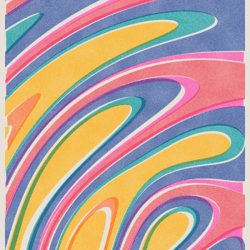

Interference by Phaust

Items
236
Created
20-07-2023
Creator fee
-
Chain
Ethereum
Mint Price
-
In Interference, Phaust foregrounds two scientific discoveries in a search for purity of generative systems—an 18th century German physicist and a 20th century Japanese electronics corporation. Investigating acoustics, Ernst Chladni took a violin bow and drew it against a metal plate lightly covered with sand. When the plate reached resonance the sand would settle on particular nodal lines–leaving what is known as Chladni patterns. These proved to be important in fields as diverse as acoustics and instrument design to wave theory and quantum mechanics. Chladni patterns vary according to a range of factors and can be described with some pleasingly simple equations. Those equations lie at the heart of this collection and perhaps show generative art at its purest: a set of simple equations which give rise to near infinite variation. Phaust drew upon a 1980 invention by the Riso Kagaku Corporation to bring these forms to life–a machine that looks like a photocopier but works like a screen printer. The Risograph uses stencils and vibrant semi-transparent spot color inks to print a single layer of color at a time, producing prints that are vivid, textured and unique thanks to subtle imperfections in the printing process. Interference embraces the quirks of Risograph printing, adopting the semi-transparent colors of Riso inks and exaggerating the mis-alignment found on Risograph prints. Instead of plotting solid bands of color, the collection mimics the texture of Risograph prints through over half a million distinct tiles, each subtly varied in shape and color. This treatment suggests mosaics when viewed up close and harkens back 200 years to sand particles settling along nodal lines on Chladni's plates. Unlike earlier collections such as Pointilla, where the artists had to define much of the forms through code, this is fundamentally a handful of mathematical functions and transformations that create a dramatic variation of composition. Phaust chooses to break the faithful presentation of a physical phenomenon by deviating from standard Chladni patterns — introducing polar coordinates that create a pinching effect to otherwise more rounded forms and an additional distortion that occasionally disturbs these flows. These interventions remind the viewer that this is an unreal depiction, algorithmically generated. This mathematical and conceptual simplicity speaks directly to the beauty of generative systems. By foregrounding a familiar physical phenomenon, the vibration of sound, Phaust elevates the unique beauty of generative art.
Total Volume
Floor Price
24H Volume
Listed
Owners
Unique Owners
Interference by Phaust graphique prix plancher
24h
1s
1m
3m
6m
1a
Tout
Mise à jour du prix
Le prix plancher actuel de Interference by Phaust est de 0.015 ETH et le volume de trading sur 24 heures
est de - avec - ventes. Le prix plancher est down 0% au cours des dernières 24 heures.
Combien y a-t-il de Interference by Phaust ?
Interference by Phaust est la collection de NFT de 236 tokens non fongibles qui a été lancée sur la Blockchain Ethereum en -.
Quel était le prix de frappe ?
Le prix de Interference by Phaust à sa sortie était de - pour chaque NFT.
Comment puis-je obtenir Interference by Phaust ?
Vous pouvez acheter Interference by Phaust sur des marchés secondaires comme : OpenSea, X2Y2, Blur, LooksRare, Gem, Uniswap,
Quelle a été la vente la plus élevée de Interference by Phaust ?
La vente la plus élevée de Interference by Phaust a été réalisée avec un prix de vente de -
Actifs
Avoirs
Prix de liste : du plus bas au plus élevé

Aucun actif à afficher
N'hésitez pas à en ajouter un de cette Collection.

